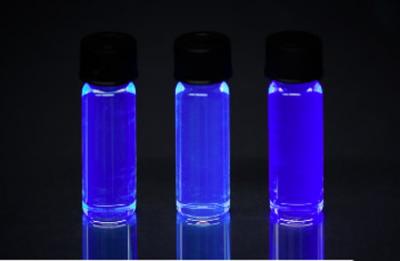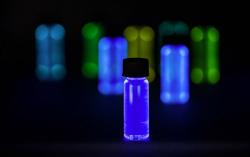In May 2017 Cynora announced a new blue TADF emitters that achieves a 15% EQE at 1000 nits with an emission peak of 470 nm and a LT97 of > 90 hours (at 700 nits) on a device level. Cynora has stated several times that it aims to commercialize its first highly efficient blue TADF emitter by the end of this year.

According to Cynora, the performance requested from customers is an EQE (at 1000) of over 15%, a lifetime (LT97 at 700 nits) of over 100 hours and a wavelength of 460 nm (color purity FWHM 60 nm).
Cynora now presents a new deeper-blue TADF emitter at 464 nm (color purity of 58 nm). While this is closer to the target goal of 460 nm with an EQE of 15%, the lifetime (LT97, 700 nits) is only 15 hours. Still a lot of work ahead for Cynora - but the company is confident it can reach its end-of-the-year goal.
Cynora does update now that it is targeting 2019 for actual production of AMOLED displays with its TADF emitter. Mass production of Cynora's blue TADF emitter will be ready in Q1 2018, but panels makers usually take about a year to bring a panel to the market. Cynora is partnering with global chemical makers and has yet to select a company to do its production when its materials are ready.

One of the questions people often raise is the low lifetime goal of 100 hours at LT97. People usually quote the number of 30,000 hours at LT50 for some applications. There are two important things to consider here. First - the lifetime graph is exponential which means that it the drop in brightness per hour decreases in time. In addition, Cynora's test is accelerated and is performed at a high brightness (700 nits) - higher than real world applications (most mobile phones have a maximum brightness that is lower than 500 nits, and are not used at this setting most of the time). Cynora says that average operational brightness of the Galaxy S8 for example (as reported by DisplayMate) is 460 nits.
In a recent DSCC interview, Cynora explains why it is easier to reach a deeper-blue using a TADF emitter compared to a phosphorescent one. Cynora says that "In phosphorescence, the higher energy involved in blue emission acts to destabilize the host material and the emitter, so improvements in color point go hand-in-hand with reduced lifetime". This was a rather confusing remark and we asked for explanation. Cynora tells us that "Phosphorescent blue did not only have issues with the stability of the metal-complexes that are used as emitter but it is also rather difficult to make host materials that are stable enough for the high energy that is needed to pump the blue phosphorescent emitters. In case of TADF emitters, the requirement for the triplet energy is slightly lower than for phosphorescent emitters but in this energy range any small energy decrease helps to boost the stability significantly".
Finally, Cynora updated us on its red and green TADF emitter project. While Cynora currently focuses on blue emitters, the company also has a plan to develop green and red - which will begin after it finishes the blue development by the end of this year. Cynora believes that it has developed an expertise in mastering FWHM for blue and this should enable a relatively easy route towards a green TADF emitter which essentially has the same color specs as the current phosphorescent emitters. The company expects its green emitter to provide a stability improvement at similar efficiencies versus the state of the art. The company envisions a development time of 12 months or so for the green material, which means that the green emitter should reach customer specifications by the end of 2018. Red will follow one year later.

